#Monferrato Active
Explore tagged Tumblr posts
Text
"Nuoto in cartella 2024": L'iniziativa di Casale Monferrato per avvicinare i bambini allo sport
Dal 14 ottobre 2024 al 31 gennaio 2025, gli alunni di seconda elementare di Casale Monferrato potranno partecipare a lezioni gratuite di nuoto presso la piscina comunale.
Dal 14 ottobre 2024 al 31 gennaio 2025, gli alunni di seconda elementare di Casale Monferrato potranno partecipare a lezioni gratuite di nuoto presso la piscina comunale. Casale Monferrato rinnova l’impegno verso i più piccoli e le loro famiglie con l’edizione 2024 di “Nuoto in cartella”, un’iniziativa rivolta agli alunni di seconda elementare. Il progetto, pensato per promuovere uno stile di…
#attività extrascolastiche.#Attività Fisica#attività fisica per bambini#attività pomeridiane bambini#attività sociali Casale Monferrato#attività sportiva Casale Monferrato#Casale Monferrato#eventi sportivi Casale Monferrato#impegno sociale#iniziative sportive Casale Monferrato#lezioni di nuoto#lezioni gratuite#Monferrato Active#nuoto bambini#nuoto Casale Monferrato#Nuoto in cartella#nuoto in Piemonte#piscina comunale Casale Monferrato#piscina comunale via Giovanni Paolo II#progetto educativo#progetto scolastico#promozione dello sport#promozione sportiva#salute bambini#seconda elementare#sport e benessere#sport e famiglie#sport e salute#sport per bambini#supporto famiglie
0 notes
Text

Ketubbah from Casale Monferrato, 1772
Celebrating the marriage of Meir ben Johanan Solomon (known as Jonah Zalman) and Zipporah bat Simeon Hayyim Levi Morello on Friday, 1 Adar II 5532 (March 6, 1772).
This exquisitely decorated marriage contract records the wedding of members of two of the most important families in the Piedmontese town of Casale Monferrato. The groom, Emilio Meir Vitta Zalman (1756-1820), was the scion of a prominent family of landowners and bankers. He was a lay member of Napoleon’s Sanhedrin, and his son, Giuseppe Raffaele Vitta, was made a baron in 1855 for his contribution to the nation in assisting soldiers wounded in the Crimean War.
The document is lavishly decorated with a richly colored floral border within which cupids frolic. The family emblems of the groom and bride adorn the ketubbah and appear in ovals at the top right and left of the document. The tapered shape of the parchment’s lower portion is a characteristic feature of ketubbot from Casale Monferrato and gives the document the appearance of a shield. The small but active Italian Jewish community of Casale Monferrato is well known for its synagogue, an architectural jewel of baroque magnificence, as well as for the production of beautiful ceremonial objects. Surprisingly, however, fewer than a dozen decorated ketubbot from seventeenth- and eighteenth-century Casale Monferrato survive, and the present marriage contract is a rare, splendid example of the manner in which the Jews of Piedmont would celebrate their joyous occasions.
23 notes
·
View notes
Text
The Italian Wars: the Truce of Nice of 1538
On this day in history, the 18th of June 1538, the Truce of Nice was signed, ending the Italian War of 1536–38 between King François I of France and Holy Roman Emperor Charles V.
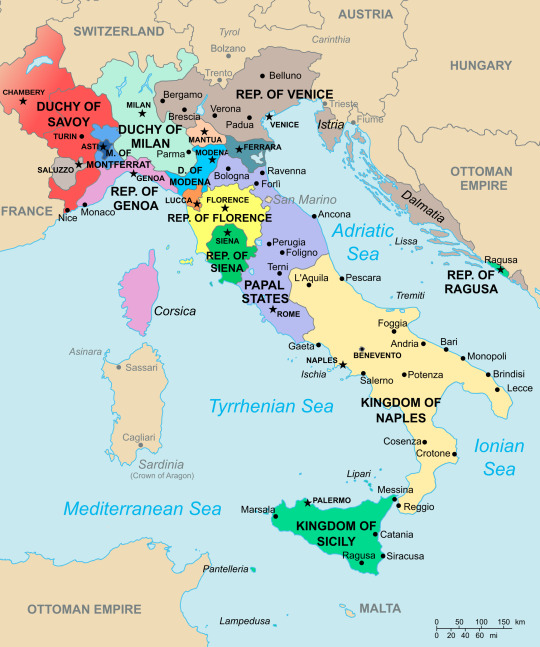
The Italian Wars, which are often referred to as the Habsburg-Valois Wars, were a series of military conflicts between 1494 and 1559. They included the following campaigns:
First Italian War of 1494-1498, or King Charles VIII’s War;
Second Italian War, or King Louis XII’s War (1499–1504);
War of the League of Cambrai (1508–1516);
Italian War of 1521–1526, which ended with the Treaty of Madrid;
War of the League of Cognac (1526–1530), which included the Treaty of Cambrai;
Italian War of 1536–1538, which ended with the Truce of Nice;
Italian War of 1542–1546 when both Charles V and Henry VIII invaded France;
Italian War of 1551–1559, which finished with the acceptance of the Peace of Cateau-Cambrésis by Henri II of France, who renounced all his claims to Italy in this treaty.
The Valois-Habsburg Wars altered the political landscape in Italy and Europe. Italy was a center of conflicts between the Houses of Habsburg and of Valois for decades. Throughout those wars, territories were conquered and lost; numerous men from participating countries were killed; ruling dynasties were overthrown and new ones established; some Italian states were annexed and others appeared. Eventually, the Habsburgs won the battle for dominance in the region, which marked the end of Italian political independence. Yet, despite the Spanish control in centuries to come, there would still be some room for maneuver for small Italian city-states and for princes.
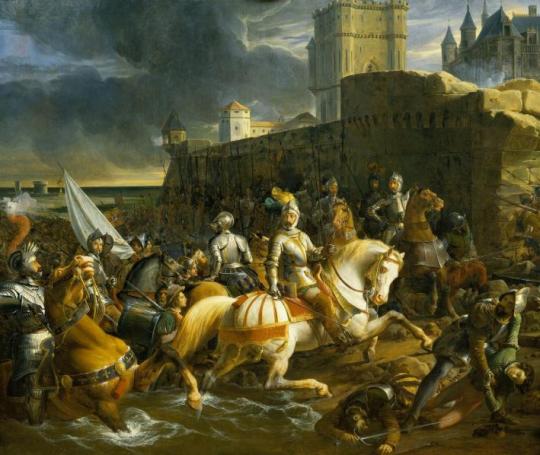
The Valois and the Habsburgs both had dynastic claims on Italy. The Italian War of Charles VIII was triggered by his hereditary claims to the throne of Naples, which had once ruled by an Angevin dynasty. The Spanish monarchs possessed the hereditary claim to Naples as heirs to Alfonso V of Aragon, who had subjugated the kingdom and left it to his illegitimate son, Ferrante, in 1458. The d’Orléans and d’Angoulême, the cadet branches of the Valois royal dynasty, claimed to be the rightful heirs of the Visconti Dukes of Milan, who had died out in 1447.
As of 1498, the Duchy of Milan was an Imperial fief. When in the same year, Louis d’Orléans, grandson of Valentina Visconti, ascended the French throne, he considered his claim to Milan part of his inheritance. Valentina was also the paternal grandmother of François I, Louis’ cousin, so François considered Milan his inheritance. Soon after his accession in 1515, François I continued Louis XII’s campaign against the League of Cambrai in Italy and emerged triumphant in the Battle of Marignano; according to the treaties of Noyon and Brussels signed in August 1516, the entirety of northern Italy was surrendered to France and her ally, Venice, including the Duchy of Milan.
Nevertheless, holding the Duchy of Milan was more difficult than François had initially planned. As soon as Charles von Habsburg (heir to the Spanish kingdoms as well as the lands of the Dukes of Burgundy) came to power, he reminded the world that most of northern and central Italy must be part of the Holy Roman Empire. Charles reconquered Milan from the French in 1521 and granted it to Francesco Sforza, Duke of Milan, in 1522.

King François I, Emperor Charles V, and François’ capture at Pavia
In order to restore his holdings, François personally led his troops into Lombardy in 1525, but it all ended with his captivity at Pavia on the 24th of February 1525. Later the French monarch was imprisoned in Spain for more than a year, and then he was compelled to sign the Treaty of Madrid in January 1526, in which he gave up his claims to Italy, Flanders, and Burgundy in exchange for his release from prison. Then two French princes – Dauphin François and Henri, Duke d’Orléans – would spend several gruesome years in Spain, held as hostages by Charles.
However, not even the captivity of François’ sons destroyed his designs on Italy. Between 1530 and 1536, François was determined to recover at least some of what he had lost. He still had many supporters in Italian city-states; there were also opponents of the emperor who were dissatisfied with his rising power. Throughout his life, François firmly believed that Genoa, Milan, and Asti were all rightfully his, but recovering Milan was his main goal. He stated that half of the lands of Savoy should belong to him as heir of his mother, Louise, who had passed away in 1531.
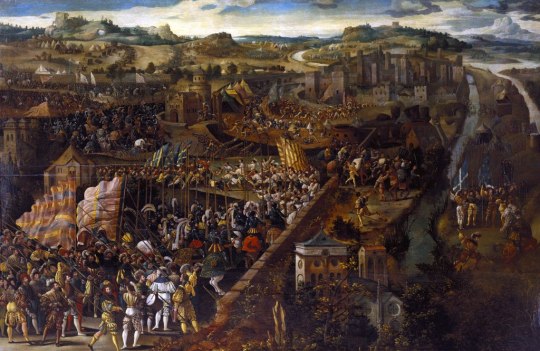
At the beginning of 1536, King François told his council that Charles V had become too powerful in Italy and that his archrival’s appetites for conquests must have been curbed. In February 1536, many legions of French infantry marched towards Savoy and soon occupied it. In late March, a French army (24,000 infantry and 3,000 horses) under the leadership of Philippe de Chabot, Admiral de Brion, captured Piedmont and then entered Turin in early April, but they failed to take Milan. At the same time, French partisans in Asti overthrew the Imperial viceroys.
In response, on the 25th of July 1536, the Imperial army entered Provence, taking the coast road through Nice. At the same time, Henry, Count of Nassau, commenced an invasion of Picardy from the north. François and his generals concentrated their attention on the south of their country, where Montmorency used a scorched-earth strategy in order to devastate the naturally fertile land so as not to leave any supplies for the invaders. The Provencal city of Aix fell to Charles on the 13th of August, and the emperor made his camp there with his army. As the French blocked all the routes to Marseilles, Charles could not go there to get fresh supplies for his soldiers, and thousands of his men died from disease and famine.
While the Imperial troops were blocked in Provence, the French sent reinforcements (a force of 10,000 Italian infantry and a few hundred horse) to Piedmont. More Italian troops, which served François, were raised by Guido Rangone and other military nobles from southern Lombardy. In early 1536, François and Suleiman the Magnificent established an alliance between the Ottoman Empire and France. By the end of 1536, a Turkish fleet was stationed near the coast of Genoa. However, the garrison of Genoa was reinforced, and there was no uprising of Fregoso partisans (they served François) among the local populace. François’ plans to occupy Genoa did not materialize, and soon Charles returned to Italy.
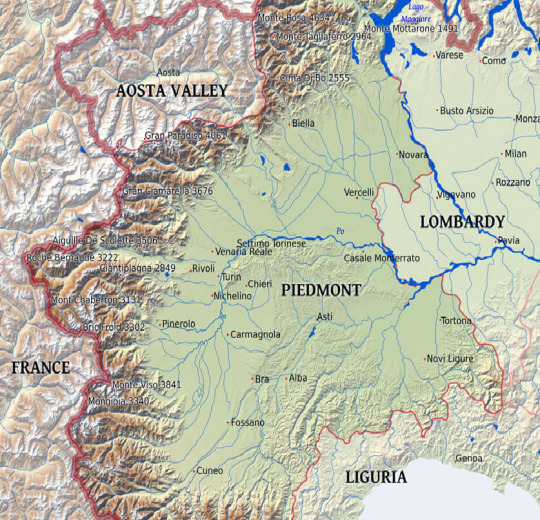
The war depleted the French treasury. François felt that negotiations with Spain were necessary, but he yearned to be in possession of as much of Piedmont as possible. Therefore, he joined his army and led his men in local skirmishes, which resulted in the occupation of the territory east of Turin to Monferrato and south to the Tanaro. In the meantime, Charles began to slowly recover control of the countryside in Piedmont, and to blockade the towns and villages held for the French.
Nevertheless, Charles V was besieged by internal and external political problems. The Turks and corsairs were becoming more active in the Mediterranean. The stability in the German lands was destroyed by religious and political troubles, and it was high time for the emperor to use a variety of means in attempt to stop the spread of Protestantism. There also was a brewing rebellion in the Netherlands. Thus, Charles was ready for a truce in Italy, just as François was.
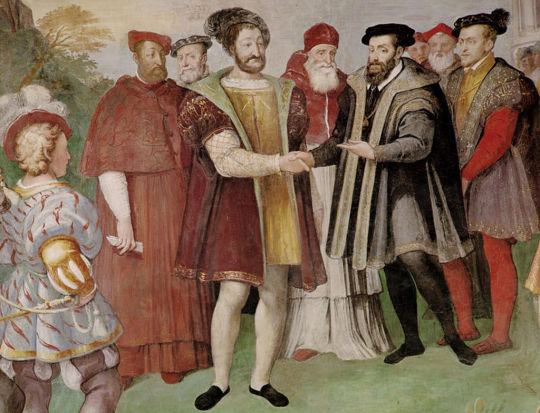
King François I and Emperor Charles V, Truce of Nice 1538
Peace talks were opened on the border between France and Spain. However, François refused all the Imperial proposals because the crux of their differences was the Duchy of Milan. As neither François nor Charles was willing to compromise, Pope Paul III became a mediator between them. Finally, the congress did finally take place at Nice, where the two rulers reluctantly agreed on a truce of ten years, and that each would keep what he held in Italy at that moment.
The Habsburg-Valois wars were far from over. The Truce of Nice did not give the King of France what he wanted to have the most – the Duchy of Milan. Even if one of his sons could inherit the duchy, François dreamed of ruling it himself. The ruler would keep chasing his ill-fated dream, and Milan would remain a major cause of contention between Charles and him in years to come.
All images are in the public domain.
Text © 2019 Olivia Longueville
#king Francis I of France#Charles V Holy Roman Emperor#the Italian Wars#the House of Habsburg#the House of Valois#wars#royals
11 notes
·
View notes
Photo

Repost from @nidodc (Washington DC) • “Vini Vivi e Dimenticati, Alive and Forgotten Wines” the slogan of Tommaso Gallina. We are happy to feature the ASOTOM Ops! Grignolino on our shelves! The ASOTOM Grignolino is a labyrinth of wet leaves, rosehips, Cigar box, pomegranate, pleasantly strong tannins & Tomato Jam. Tommaso is a self-taught winemaker who found his calling in the vineyards after studying construction planning and realizing an office job was not for him. The origin of the name ASOTOM is a curious one. On his first day of elementary school, Tommaso was asked to write his name on a label; he first wrote “TOM,” and, when he ran out of space, he wrote “ASO” above forgetting the second M. He started to make wine in 2005 after finding an old abandoned vineyard in Castelletto Merli in the Monferrato wine region of Piemonte. After bringing it back to life, he planted additional grape vines to reach about 3.5 hectares (~9 acres) of organic-certified vineyards. Tommaso and his partner, Sara, consider themselves farmers and, in addition to wine, also make olive oil and honey. They employ biodynamic farming using natural products to strengthen the vines against fungal disease and do not perform any weed management. While Tommaso works in the cellar, Sara handles all administrative and promotional activities and also manually adds the finishing touches to the wine labels. They produce about 10,000 bottles (~800 cases) per year of Barbera, Freisa, Grignolino, Moscato Nero, Timorasso, and Cortese, all of native grape varieties to his corner of Italy. (presso Washington, DC) https://www.instagram.com/p/CgoZgK2OfGU/?igshid=NGJjMDIxMWI=
0 notes
Photo

#DINNER , #RELAX AND #WINE TASTING IN PIEMONTE! Discover the Castello di Razzano positioned in one of the most panoramic corners of Monferrato and surrounded by an estate of extraordinary #natural beauty. Guests can visit the #Wine #Museum, Wine Cellars, and also Wine #Shop, where they can sample the wines and the other products of the estate or enjoying our regional food specialties prepared by #chef Daiana. Choose one of the many activities you can #book for your #holiday or just #relax by the #panoramic #swimming #pool, surrounded by vineyards. Castello di Razzano is located in the heart of the Monferrato zone of #Piedmont, about an hour from #Milan, #Turin and #Genoa. 30 kilometers from Alba. Visit and enjoy the #beautiful territory! ➤ Find out more: https://www.yeetmagazine.com . . . . . . #italy #love #instagood #italia #photooftheday #travel #photography #picoftheday #beautiful #fashion #nature #instagram (at Italy) https://www.instagram.com/p/B494_7UKbF7/?igshid=14f3lvchdyy4t
#dinner#relax#wine#natural#museum#shop#chef#book#holiday#panoramic#swimming#pool#piedmont#milan#turin#genoa#beautiful#italy#love#instagood#italia#photooftheday#travel#photography#picoftheday#fashion#nature#instagram
0 notes
Text
Dynamo12Ore 2024: Un Successo Straordinario con un Riconoscimento Nazionale
L’evento benefico di Casale Monferrato raccoglie 23.460 euro e riceve un importante premio da Dynamo Camp per l'eccellenza nell'impegno sociale.
L’evento benefico di Casale Monferrato raccoglie 23.460 euro e riceve un importante premio da Dynamo Camp per l’eccellenza nell’impegno sociale. L’iniziativa benefica Dynamo12Ore, tenutasi quest’anno a Casale Monferrato, ha ottenuto un risultato straordinario, raccogliendo ben 23.460 euro a favore di Dynamo Camp, una realtà che offre esperienze di Terapia Ricreativa per bambini affetti da…
#Attività per Bambini#attività ricreative#bambini con patologie croniche#Beneficenza#benessere infantile#Casale Monferrato#Casale Monferrato beneficenza#comunità di Casale Monferrato#Dynamo Camp#Dynamo12Ore#eccellenza sportiva#esperienze formative#Evento benefico#evento di eccellenza#evento solidale.#evento sportivo Casale Monferrato#fondi per Dynamo Camp#generosità e impegno#impegno comunitario#Monferrato Active#progetto Dynamo Camp#Raccolta Fondi#raccolta fondi 2024#riconoscimento Dynamo Camp#riconoscimento nazionale#Solidarietà#sostegno ai bambini malati#Sostegno sociale#sport e beneficenza#terapia per bambini
0 notes
Text
Alba - A Classic Regional Piemonte Town - Italy
Alba is a classic regional Piemonte town. Often Asti, the main town of the Monferrato, has the pretensions of a provincial capital, however, I agree with those writers that cite Alba as a smaller community that happily conserves much of the best of Piemonte. Between the end of the 12th and first half of the 13th century Alba enjoyed a period of prosperity, which expressed itself in the constructions of fortified buildings (towers) within the town. These towers were a mark of prestige as the higher the tower, the richer and more powerful the family that owned it. There are only four towers in Alba today that retain their original height and are concentrated around the Piazza del Duomo. There used to be 여우알바 that Alba came to be known as the town of a hundred towers. Although these towers characterize its medieval history, during the renovation of the medieval Palazzo Marro, Roman archaeological finds were uncovered showing traces of Roman Temple that existed during the 1st half of the 1st century AD. Much of the essence of Alba can be experienced walking down Via Vittorio Emanuele and Via Cavour (both closed to cars) lined with a wonderful mixture of restaurants/cafes, enotecas, clothing stores and gourmet food stores (below I have listed a few). Being the main town in the Langhe, its no surprise that Alba hosts many wine and food related events showcasing the rich wine and truffle production (to be discussed in the second part of this post). However, there is more to Alba than just wine and white truffles as the city also sponsors numerous classical music/chamber music and film events throughout the year that continually refresh the city with new residents/visitors. On a first visit to Alba I would recommend heading to the ample parking at Piazza San Paolo and then walking the few minutes to Piazza Savona, which is at the top of Via Vittorio Emanuele II, to begin your stroll. Before you turn left to walk under the short expanse of porticoes on Via Cavour you will enter Piazza Risorgimento (aka Piazza Duomo) with the medieval town hall straight ahead and Cathedral San Lorenzo to your right. Very little remains of the principal cathedral that was built between 1486-1517 and in its place is a neo-gothic cathedral built in the 19th century. Also in this piazza you will find the Alba tourist office that has an extensive selection of free information on local events/tastings/activities in English and German (the tourist office is open all day). Via Cavour is not a very long street so I suggest a little side diversion to Piazza E. Pertinace which is a nice little piazza that host a small organic food market on Saturday. Most of the Albese stores shut for siesta so be sure to plan your stroll when the stores are open which is until 12:30/1pm and then between 4pm and 7pm. I suggest select a table at one of the numerous outdoor cafes - my favourite is Vincafe' on Via Vittorio Emanuele 12 - and enjoy an aperitif during the evening "passeggiata", when the locals come out to view and be viewed. Cin cin. TorreBarolo is a renovated 17th century tower that is available to rent as a self-catered property. It is an ideal escape for those seeking the amenities and privacy of a private home, yet wanting an authentic Italian countryside experience while on holiday. From its elevated position in the village, guests can enjoy sweeping views of the vineyards and medieval hill top towns that contribute to the charm of the Langhe Valley. Guest also can enjoy the ease of having many of Barolo's restaurants and wine bars within a 5 minute walk from the tower. A short drive from Barolo, guest have many options such as dining in Alba on white truffles shaved over egg pasta or sampling the latest the Piedmont wine region has to offer, such as Barolo, Barbaresco or Barbera d'Alba wines at the numerous regional enotecas.
0 notes
Photo

Un luogo nascosto nel Monferrato, per scoprire, conoscere, rilassarsi e degustare. Una cantina storica (del vecchio Re), che vive ancora attraverso i prodotti della sua terra, tra vino, olio e frutta.. - #luoghiautentici An hidden place among the Monferrato hills in Piedmont where to discover stories, relax and taste. An historical wine cellar (of the last King), that is still open and active thanks to the products of its land (wine, oil, fruits..) https://www.instagram.com/p/Bz_GqsxiVva/?igshid=eks8bgqzce3h
0 notes